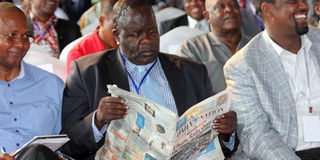A guide to reading rumour columns, misinformation, and disinformation

Homa Bay Governor Cyprian Awiti (centre) goes through Nation newspaper during the proceedings of the 2nd Devolution Conference at Tom Mboya Labour College in Kisumu on April 22, 2015. PHOTO | TONNY OMONDI | NATION MEDIA GROUP
What you need to know:
- The gang has in recent weeks been seen sending word for ‘young, strong and courageous men’ armed with pangas and clubs to temporarily join its ranks and fight off any opposing gang when the plan to grab the land on Kangundo Road is finally executed.
- Prof Jayson Harsin, an expert in media and politics, came up with the rumour bomb concept in 2006. He said rumour bombs are used as tools for political participation and social-political engineering. For example, in 2005 a consultant fabricated emails that sought to sow divisions in the ANC and manipulate the succession battle between Thabo Mbeki and Jacob Zuma.
- Psychological and sociological studies have shown that the reader’s brain often processes the initial statement as true before processing the question mark. Another technique is to make the rumour attractive or emotive — something we can share with our friends and neighbours.
Should Kenyan newspapers publish rumour columns? Because they do, perhaps a more useful question is: Should readers take the rumours at their face value?
How can readers detect propaganda (biased or misleading information in support of a cause), misinformation (false information), disinformation (deliberately false information), and rumour bombs (to be defined shortly)?
Rumours, which often malign and disparage other people and do not always tell you who the source is even when it is clear what their intentions are. Consider this: “It appears a notorious land-grabbing gang in Nairobi is preparing a major mradi — street parlance for taking over an unoccupied piece of land.
The gang has in recent weeks been seen sending word for ‘young, strong and courageous men’ armed with pangas and clubs to temporarily join its ranks and fight off any opposing gang when the plan to grab the land on Kangundo Road is finally executed.
The reward is a piece of the ill-gotten land. Our informer hopes the police will get wind of the plan and stop it before blood is shed.”
This was published in the Sunday Nation of April 19 and followed on May 3 with an update in which we were told the gang had “intensified their activities” and the writer was hopeful “the police will stop the evil plan”. This was possibly a rumour bomb. A rumour bomb is intended to achieve a social or political aim.
Prof Jayson Harsin, an expert in media and politics, came up with the rumour bomb concept in 2006. He said rumour bombs are used as tools for political participation and social-political engineering. For example, in 2005 a consultant fabricated emails that sought to sow divisions in the ANC and manipulate the succession battle between Thabo Mbeki and Jacob Zuma.
Normally, we expect the media to publish accurate and reliable information. If they peddle rumours they are not helping the reader. The media have a duty to sift through information and establish the truth so that the reader can make intelligent decisions. Quality media should not spread unverified stories, spurious or salacious rumours.
In March, the Sunday Nation joined The Star (“Corridors of Power”) and The Standard (“Palaver”) with its own “Talk of the Town” rumour column. How can we read these columns without being manipulated and conned?
You should be able to tell when the column is thoughtlessly propagating rumours — when it does not tell you that the information is unverified and when it does not identify the source. You should also be aware of the techniques used. One technique is to report rumours with a question mark (“Me! Bribed? I am too rich”).
Psychological and sociological studies have shown that the reader’s brain often processes the initial statement as true before processing the question mark. Another technique is to make the rumour attractive or emotive — something we can share with our friends and neighbours.
Such rumours are easily believed. Yet another technique is to use hedging attributions such as “reportedly”, “claims”, and “it appears”. Postscript: I have learned from a reader — and checked it out — that if you want to do better than the rumour columnists, go to the Rumour Triangle.
That is the space hemmed in by City Hall, Nakumatt, Jubilee House, and Prudential House on Wabera Street in Nairobi. Groups of fairly well-fed and groomed men huddle together every working day to whisper and spread political gossip. At least there you can tell who is talking.
*****
Did NMG need a rumour column?
Michael Hatego, an avid and critical reader, says he reads the rumour columns. “But I don’t like them at all.
They’re playing on what we’ve become as a people — lovers and purveyors of falsehoods intended for shallow, short-sided gain over our adversaries.
The columns are a danger, too, just like the opinion polls. It’s likely that some of the corruption allegations laid against some of those in ‘The List of Shame’ were actually concocted in bars and on the streets and given credence by such columns.”
He concludes: “NMG has disappointed me. Did it really need that column?”
Send your complains or concerns on editorial matters to [email protected]. You can also call or send text messages to mobile 0721989264, call 3288000 or visit the Public Editor at Nation Centre in Nairobi.





